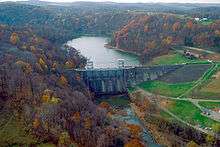Loyalhanna Creek
| Loyalhanna Creek | |
|---|---|
 Loyalhanna Lake and Dam on Loyalhanna Creek in Westmoreland County, Pennsylvania looking upriver toward the west-northwest | |
| Country | United States |
| Basin | |
| Main source | 40°07′45″N 79°20′20″W / 40.1292397°N 79.3389231°W |
| River mouth |
827 ft (252 m) 40°29′07″N 79°27′16″W / 40.4853442°N 79.4544855°WCoordinates: 40°29′07″N 79°27′16″W / 40.4853442°N 79.4544855°W |
| River system | Allegheny River |
Loyalhanna Creek is a 50-mile (80 km) long tributary of the Kiskiminetas River in Westmoreland County in the U.S. state of Pennsylvania.[1] The stream is a popular destination for canoeing and recreational trout fishing.
Etymology
The creek derives its name from the eighteenth-century village of Layalhanning, an important Delaware Indian crossroads settlement located at the site where Fort Ligonier was built, in present Ligonier, Pennsylvania. The village was settled shortly after the Delaware left the Susquehanna River area in 1727. Layalhanning means "the middle stream" in the Delaware language— "lawel" or "lawell" (middle); "hanna" (a river or stream); "ing" (at the place of).[2]
Course
Loyalhanna rises from Laurel Ridge in southern Westmoreland County, north of Donegal and flows NNE, along the southeastern side of Chestnut Ridge. Approximately 5 mi (8 km) northwest of Ligonier it turns northwest, cutting through Chestnut Ridge and passing through Latrobe. From Latrobe, it flows NNW, passing through Loyalhanna Lake reservoir and joins with the Conemaugh River to form the Kiskiminetas River at Saltsburg. The creek lies about midway between the Juniata River to the east and the Ohio River to the west, and about halfway between the Conemaugh River to the north and the Youghiogheny River to the south.[3]
Watershed
Decades before the 2000s, the lower end of the creek, beginning above Latrobe, was colored red due to acid from local mines. Rocks in the area are still stained red from the effects. In subsequent years, with the growth of environmental sensitivity, a remediation pond was installed near St. Vincent College that removes 90 percent of the iron oxide from the water.[4] klmklnn
Claims of Bigfoot sightings
Sam Sherry, of Wilpen, claimed to have encountered a Bigfoot while night fishing along Loyalhanna Creek on May 17, 1987. Sherry gained notice from Bigfoot enthusiasts and spent much of his life investigating the phenomenon in the area.[5]
See also
References
- ↑ "Loyalhanna Creek". Geographic Names Information System. United States Geological Survey. Retrieved 2011-04-23.
- ↑ Sipe, Chester Hale (1971). The Indian Wars of Pennsylvania. Amos Press. p. 750.
- ↑ Shirey, Sally (2001). Ligonier Valley. Arcadia Publishing. p. 10.
- ↑ Hayes, John (March 30, 2008). "Loyalhanna Creek's diversity makes it a valuable angling classroom". Pittsburgh Post-Gazette. Retrieved February 12, 2011.
- ↑ Gordon, Joe (May 26, 2007). "Man gained fame tracking Bigfoot". The Tribune-Democrat. Retrieved February 12, 2011.
External links
| Wikimedia Commons has media related to Loyalhanna Creek. |
- U.S. Geological Survey: PA stream gaging stations
- Loyalhanna Dam pictures
- U.S. Army Corps of Engineers: Loyalhanna Lake